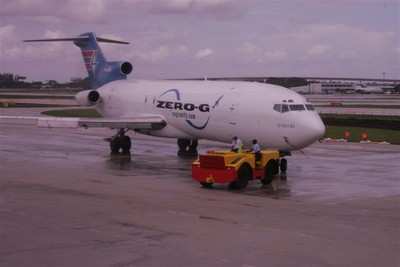Fri, Oct 07, 2011
Nine Experiments To Fly On Suborbital Rockets And Zero-G
Parabolic Aircraft
NASA has selected nine proposals to demonstrate new technologies
for the second set of payloads to fly on commercial suborbital
reusable launch vehicles and the Zero-G commercial parabolic
aircraft. NASA is using commercially available vehicles to carry
these technology demonstration payloads to help develop the U.S.
commercial reusable suborbital transportation industry.

NASA's Flight Opportunities Program provides test flights to
demonstrate and validate space technologies on airborne platforms
flying above 65,000 feet, the area known as "near space." The
program also supports parabolic flights that simulate brief periods
of microgravity or weightlessness. "We're moving out with a set of
payloads that can benefit from the proving ground of near space,"
Mike Gazarik, director of NASA's Space Technology Program at NASA
Headquarters in Washington said. "We're looking forward to
increasing the number of commercial flights and technology
demonstration payloads flown, with companies providing a viable
reusable flying science lab capability for researchers from all
across America."
Selected for flight on both a suborbital reusable launch vehicle
and the Zero-G aircraft is "Microgravity Multi-Phase Flow
Experiment for Suborbital Testing," team leader Kathryn Hurlbert of
NASA's Johnson Space Center in Houston.
Selected for flight on suborbital reusable launch vehicles:
- "Application of Controlled Vibrations to Multiphase Systems for
Space Applications," Ricard Gonzalez-Cinca, Universitat Politecnica
de Catalunya, Barcelona, Spain, and Richard Tyson, University of
Alabama in Huntsville
- "Environmental Monitoring Suite on Suborbital Reusable Launch
Vehicles," H. Todd Smith, and Lars P. Dyrud, Johns Hopkins
University Applied Physics Laboratory, Laurel, MD.
- "Measurement of the Atmospheric Background in the Mesosphere as
a Pre-cursor to Astronomical Observations," Sean Casey, USRA/SOFIA,
Moffett Field, CA.
- "RF Gauging of the Liquid Oxygen Tank on a Reusable Launch
Vehicle," Gregory Zimmerli, NASA's Glenn Research Center,
Clevelandm OH.
Selected for parabolic flight aboard the Zero-G aircraft:
- "Assessing Vestibulo-Ocular Function and Spatial Orientation in
Parabolic Flight," Mark Shelhamer, Johns Hopkins University School
of Medicine, Baltimore, MD.
- "Evaluation of a Medical Chest Drainage System Functional in
the Microgravity Environment," C. Marsh Cuttino, Orbital Medicine,
Inc., Richmond, VA.
- "Autonomous Cell Culture Apparatus for Growing 3-Dimensional
Tissues in Microgravity," Zarana Patel and Janice Huff of Johnson
and Colin Pawlowski of Yale University
- "A demonstrated application of a cost effective and novel
platform for non-invasive acquisition of physiologic variables from
spaceflight participant candidates," Ravi Komatireddy, University
of California at San Diego and West Wireless Health Institute of
San Diego, CA.

The Zero-G aircraft flights are expected to take off in April
2012 from Ellington Field in Houston. The suborbital reusable
launch vehicle payloads are expected to fly on vehicles produced by
Armadillo Aerospace, Masten Space Systems, Near Space Corporation,
UP Aerospace, Virgin Galactic, Whittinghill Aerospace, or XCOR
Aerospace. NASA selected the seven companies in August to integrate
and fly space technology payloads. The suborbital reusable launch
vehicle payload flights tentatively are scheduled to begin in early
2012.
NASA selected the proposals following an announcement of fight
opportunities issued last December. NASA called for proposals that
demonstrate or mature new technology payloads using parabolic
aircraft or suborbital reusable launch vehicles for reduced gravity
or near-space flights. The announcement will remain open until
December 31, 2014.
More News
Airbus Racer Demonstrator Makes Inaugural Flight Airbus Helicopters' ambitious Racer demonstrator has achieved its inaugural flight as part of the Clean Sky 2 initiative, a corners>[...]
A little Bit Quieter, Said Testers, But in the End it's Still a DA40 Diamond Aircraft recently completed a little pilot project with Lufthansa Aviation Training, putting a pair of >[...]
Line Up And Wait (LUAW) Used by ATC to inform a pilot to taxi onto the departure runway to line up and wait. It is not authorization for takeoff. It is used when takeoff clearance >[...]
Contributing To The Accident Was The Pilot’s Use Of Methamphetamine... Analysis: The pilot departed on a local flight to perform low-altitude maneuvers in a nearby desert val>[...]
From 2015 (YouTube Version): Overcoming Obstacles To Achieve Their Dreams… At EAA AirVenture 2015, FedEx arrived with one of their Airbus freight-hauling aircraft and placed>[...]
 Airbus Racer Helicopter Demonstrator First Flight Part of Clean Sky 2 Initiative
Airbus Racer Helicopter Demonstrator First Flight Part of Clean Sky 2 Initiative Diamond's Electric DA40 Finds Fans at Dübendorf
Diamond's Electric DA40 Finds Fans at Dübendorf ANN's Daily Aero-Term (04.23.24): Line Up And Wait (LUAW)
ANN's Daily Aero-Term (04.23.24): Line Up And Wait (LUAW) NTSB Final Report: Extra Flugzeugbau GMBH EA300/L
NTSB Final Report: Extra Flugzeugbau GMBH EA300/L Classic Aero-TV: 'Never Give Up' - Advice From Two of FedEx's Female Captains
Classic Aero-TV: 'Never Give Up' - Advice From Two of FedEx's Female Captains




